The Basic Categories:
Malt is extracted into two forms, dry malt extract (DME) and liquid malt extract (LME). These two categories are then divided into many types, each with different colors and flavors. You may find recipes that call for only LME, only DME, or for both types of malt extract.
The ‘kit beers’ that most home brewers start with are actually just versions of LME with hops already added.
Dry Malt Extract
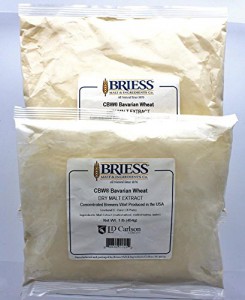 DME is most often used as a booster for kit beers once the home brewer realizes that adding sugar to beer is a bad idea. For actual extract brewing recipes, DME is used less often than LME, but has the advantage of being easy to store.
DME is most often used as a booster for kit beers once the home brewer realizes that adding sugar to beer is a bad idea. For actual extract brewing recipes, DME is used less often than LME, but has the advantage of being easy to store.
Specific Gravity:
1kg of DME in 10 liters of water = 1.038 SG
1 pound of DME in 1 gallon of water = 1.045 SG
Pros:
- You can use just a little bit and store the rest
- More temperature tolerant than LME
- Easier to measure/greater accuracy than LME
- Usually more cost-effective than LME
Cons:
- Reacts badly to humidity
- Less types of DME available to homebrewers
Common Types of Dry Malt Extract
When I started brewing, I really only had the three types available. However, there is thankfully more choice available now.
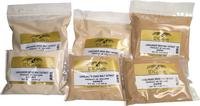 Extra Light, for use in very pale beers (usually lagers)
Extra Light, for use in very pale beers (usually lagers)- Light, Pilsner or Pale, great all-purpose malts used as the base in almost any extract beer style
- Wheat, for wheat beers, blondes, and as a secondary ingredient
- Amber, when a darker, sweeter beer is desired
- Dark, for stouts, porters, and anything black.
Many manufacturers, Briess in particular, are now increasing the range of dry extract available in homebrew quantities.
Liquid Malt Extract
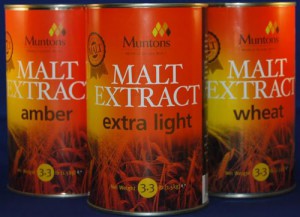 Hopped LME, usually known as ‘kit beer,’ is widely available but deserving of a whole new article. Below is information related to unhopped types of liquid malt extract.
Hopped LME, usually known as ‘kit beer,’ is widely available but deserving of a whole new article. Below is information related to unhopped types of liquid malt extract.
LME is very convenient to use if you don’t mind being committed to the exact amount you are given in the can. There is much more to choose from and the malt flavor is often better.
Specific Gravity:
1kg of LME in 10 liters of water = 1.031 SG
1 pound of LME in 1 gallon of water = 1.037 SG
Pros:
- Usually better flavor than DME
- Much greater range of choice
- Conveniently available in cans
- Great for use as base malt
Cons:
- Very tricky to measure (probably not worth it)
- Harder to store once opened
- Usually less cost-effective than DME
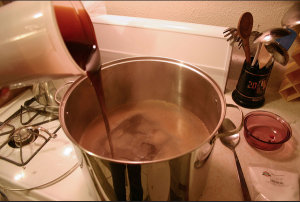 LME manufacturers like Coopers, Black Rock, and Briess have increased their offerings, so that you can now find single malt extracts combinations for certain styles as well as all the traditional favorites.
LME manufacturers like Coopers, Black Rock, and Briess have increased their offerings, so that you can now find single malt extracts combinations for certain styles as well as all the traditional favorites.
- Extra Light, for use in very pale beers (usually lagers)
- Light, Pilsner or Pale, great all-purpose malts used as the base in almost any extract beer style
- Wheat, for wheat beers, blondes, and as a secondary ingredient
- Amber, when a darker, sweeter beer is desired
- Dark, for stouts, porters, and anything black.
- Vienna or Munich, great for German-style lagers
- Rye, for very specific rye beers
- Sorghum, for gluten free beers (aka gluten free malt or white sorghum malt)
For extract brewing, LME provides access to a much greater range of styles. I personally prefer the Briess malt extracts, which are widely available through Adventures in Homebrewing, eBay or Amazon.
Say Goodbye to Brewing With Sugar
With the range of different types of malt extract now available, you should be able to brew a great beer in any style without the need for sugar as a fermentable additive.
Cheers!
I hope you found this article useful! If you have a question or something to add about the types of malt extracts, please leave a comment below.
Read Next: Drink Counting Beer Koozies; Personalized Gifts for Brewers




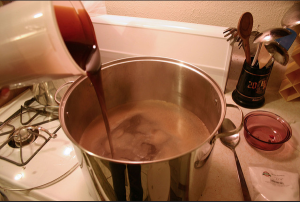
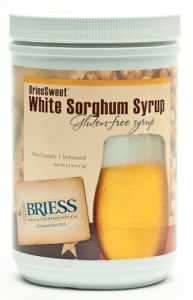
Hi Jesse,
You have an amazing idea “Making Beer”! You make me want to learn how to make my own beer. Your website is simple and informative! I like the captivating images on your website. Is it expensive to make beer? What is the average cost to make your own beer?
Hi Zoey,
That is an impossible question to answer, as there are so many variables. You can make beer for much less than you can buy it, although occasionally I have made very specialized beer at home which cost nearly as much as buying it – although the product was much better!
Very interesting. I read a magazine article a while back about artisan beers, and I wondered how it was done. I feel like I’m a little more educated on the subject now. I’m wondering though — are there any legal issues involved? (Can’t help thinking about the moonshine runners back in the hills of North Carolina where I used to live.)
Hi lynn, I believe in the US it may depend on the state or county in which you live. Certainly it is legal to brew your own beer in many parts of the USA, but please check any local laws that may be in effect.
I didn’t realize there were so many differences in malts. And I learned in this very interesting post that when malt is used you don’t have the need to add sugar for that fermenting process anymore. I’m learning so much in this new hobby I’ve chosen to start. I’ll be looking at pore of your posts to see what else I can take in.
Thank you
Thank you for sharing the types of malt extract with their pros and cons. I think this is crucial information if you want to make beer.
Be Blessed
Linda
What is the difference between using malt extract when homebrewing and just using regular malts (two row, flaked, chocolate etc)? Is malt extract just another way of cutting corners and therefore impacting the taste of the beer? Forgive my ignorance. Also, do malt extracts work better for certain beer styles than others? I think malt extract’s performance is also very dependent on the type of yeast strain used.
Hi Elan,
Thank you for your question. Malt extracts are usually used to save time when brewing beer, or as an easy, less complicated method than a full mash. This is why beginners often start with extracts. If you have good quality extracts, they can perform nearly as well as malted grain, but you have a little less control over the finished product.
In terms of style, you are only limited by the availability of the type pf malt you want – not everything comes in an extract form. That said, using just a little extract in a partial mash (partly grain, partly extract) can work very well, especially in higher alcohol beers.
Cheers!